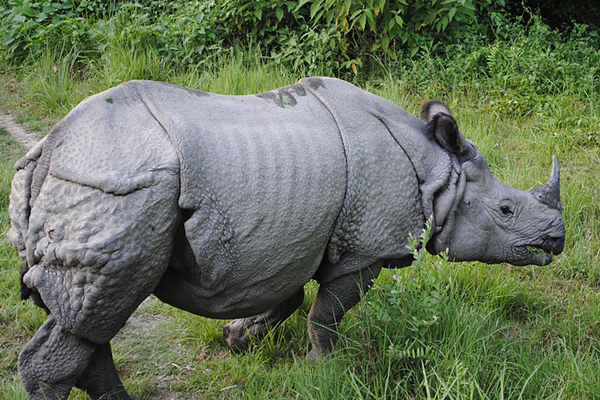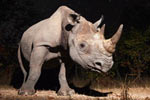
Indian rhino in Bardiya National Park in Nepal. Photo by: Krish Dulal/Creative Commons 3.0.
With the aid of Interpol, authorities have arrested the leader of a rhino poaching gang responsible for killing 20 Indian rhinoceros in Nepal. Last month, authorities nabbed Raj Kumar Praja in Malaysia where he had been evading capture for two years. Kumar was already evicted of 15 poaching incidents in absentia and sentenced to 15 years in prison.
Last week, Nepalese authorities put 31-year-old Praja before the media where he admitted to killing 20 rhinos and injuring another five.
“I earned [$40,000-45,000] by selling the horns, but I could not save any money,” Praja told reporters.
Praja’s rhino poaching gang was rounded up and arrested in 2013, but Praja got away. He went to Sinapore and then Malaysia, living under a false passport. After his escape from Nepal, Praja was put on the Interpol Red Notice, which helps local police find criminals who are wanted abroad. Interpol has recently taken much greater efforts to combat wildlife trafficking and other environmental crimes, such as illegal logging.
“This arrest sends a strong message to criminals hiding in a foreign country that no matter where they are, they are not safe and will be caught one day,” said the director of the Nepal Police Central Investigation Bureau, Hemant Malla Thakuri.
Only found in India and Nepal, Indian rhinos (Rhinoceros unicornis) are listed as Vulnerable by the IUCN Red List. Although targeted by poachers, Indian rhinos to date have largely avoided the level of poaching occurring in places like South Africa and Mozambique. Today there are over 2,500 Indian rhinos and the population is rising.
Poachers are slaughtering rhinos for their horns, which are ground up into a powder and consumed for supposed curative properties. However, scientific studies have found no curative element in rhino horn and compare their consumption to eating one’s fingernails, since both are made largely of keratin. Today, all rhinos are threatened with extinction and three of the five species are considered Critically Endangered.
Related articles
|
1,215 rhinos butchered in South Africa in 2014 (01/22/2015) 1,215: that’s the total number of rhinos butchered last year in South Africa for their horns. The number represents another annual record—the seventh in a row—topping last year’s total by 195 rhinos. South Africa houses the bulk of the world’s rhinos (around 80 percent), but has also become the center of the illegal poaching trade. |
|
How black rhinos and local communities help each other in Namibia (01/07/2015) Africa’s rhinos are in a state of crisis. Poaching for their horn has resulted in the deaths of thousands of animals and pushed the continent’s two species—the white and black rhino—against the wall. Yet, despite the crisis, there are pockets of rhino territory where poaching remains rare and rhinos live comparatively unmolested. Indeed, one of the brightest spots for rhinos is in Namibia. |
|
Then there were five: rhino death moves species closer to extinction (12/15/2014) As if news for rhinos couldn’t get any worse: this weekend, Angalifu, died a the San Diego Zoo. Forty four-year-old Angalifu was a male northern white rhino and his death means only five of this subspecies remains on the planet. Angalifu’s death, which keepers suspect was simply from old age, follows soon after the death of another northern white rhino, Suni, in October. |
|
Rhino conservationist dead at 87 (12/04/2014) South African conservationist Ian Player has died at the age of 87. |
|
Is captive breeding the final resort for the Sumatran rhino? (12/03/2014) Nearing extinction, the Sumatran rhino is running out of options. A native of Indonesia and Malaysia, the Sumatran rhino has declined in the past 30 years from an estimated 800 individuals to no more than 75 remaining today. So far there have been three ad hoc meetings held in 1984, 1993, and 2013, each attempting to develop policies that would potentially save this critical species. |
|
Rhino, cheetah win the world’s top camera trap photo contest (12/02/2014) Two big—and endangered—mammals took 2014’s top prizes in the world’s biggest camera trap photo contest: a black rhino and a Asiatic cheetah. The gorgeous shot of a black rhino at night in Zambia photo won the overall photo competition, while the image of a super-rare Asiatic cheetah in Iran took the top research prize. |

-_-A-desert-adapted-black-rhino-in-north-west-Namibia.150.gif)

